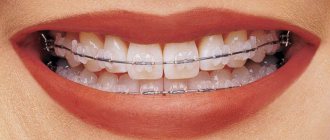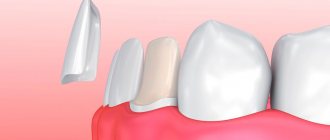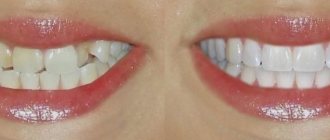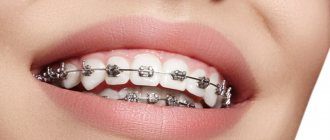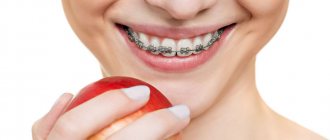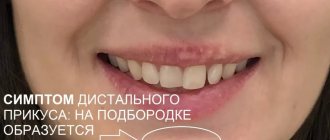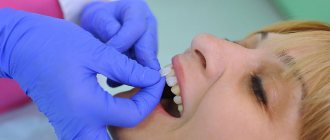Correct your bite or dental defect with invisible aligners Find out what it is
| COMMON DATA | ALINERS | BRACKETS | VENEERS |
| What they look like | transparent mouth guards for temporary wear | temporary sticker on teeth + wire | permanent sticker on teeth |
| Color spectrum | transparent | the most diverse | white or the color of the patient’s teeth |
| Material | polymer | metal/polymer/ceramics | polymer/porcelain/ceramics |
| Transparency | Yes | No | Yes |
| Possibility of metal allergy | No | Yes | No |
| Suitable for children under 16 years old | no But the technology is being developed for children from 7 years old. | Yes | not earlier than the formation of enamel of permanent teeth is completed |
Seriously speaking, it is best to be treated with aligners
Yes, I want to book a free consultation on aligners in my city!
If braces and veneers - we all understand that they are visual and what they are, then aligners
- These are the lightest transparent mouthguards made of solid polymer.
When you put on the aligners, you see your entire dentition (the aligners become invisible).
And this is a plus for aligners
Also, the advantages of aligners include the absence of allergies, just like veneers. Braces cannot boast of this.
By the way, you can find out in 1 minute whether aligners are right for you or whether doctors will forcibly offer only braces: you need to answer only 9 express questions
.
But the main general advantage of braces is that they can be installed in childhood. Although, according to the scientific development department of Star Smile, aligners are now being developed for children from 7 years of age. If this works out, then the undisputed leadership in the overall comparison will go to the aligners.
Is it necessary to use additional products to clean braces?
On forums (and sometimes in the recommendations of “experts”!) there are numerous additional products that supposedly make oral hygiene easier in the presence of braces (rinses, ultrasonic brushes, etc.)
In fact, with a responsible approach, it is quite possible to get by with three basic tools (toothbrush, dental floss, brush). In this case, you should not rely on someone else’s opinion. The quality of care will be assessed by a doctor who conducts regular examinations, and he will also recommend additional remedies, if necessary.
Preparation for treatment with braces, veneers and aligners
| Preparing for treatment | ALINERS | BRACKETS | VENEERS |
| Virtual setup: a computer program allows you to create a three-dimensional model of the dental system | Yes | No | Yes |
| Opportunity to discuss the results and progress of treatment with the doctor | Yes | No | Yes |
| Patient participation in treatment | Yes | No | No |
When a patient sees on the computer his future smile, in which all the teeth are aligned, it seems fantastic. But in fact, the 3D virtual setup is a super program from Star Smile, considered one of the best in the world and used by clinics in more than 25 countries
world and
100 cities of Russia
. This program for visualizing the future result of treatment using more than 40 parameters simulates all processes of bite correction and allows you to accurately plan treatment. Exactly with the same great result that the patient will see BEFORE the start of treatment.
Braces do not have this option - all treatment is carried out blindly, and the patient can only live in hope for the future.
And a huge plus in preparing and conducting treatment is the participation of the patient. The aligners are removable and are completely under the control of the person being treated. Therefore, the answer to the question: “What is better - braces or aligners at the initial stage?” — aligners.
Is there a need to give up your usual food?
As a rule, when installing a brace system, the doctor will actually announce “forbidden” foods, and this list looks quite depressing (cookies, chips, seeds/nuts, crackers, chewing gum, pizza, chocolate bars, etc. - everything that can stick to the structure , creating conditions for the proliferation of microbes, or damaging it). But in this case, the doctor’s recommendations should be approached in a differentiated manner: there is a clear reinsurance here, the only thing that is actually required from the patient is caution.
Manufacturing and installation of bite correction systems
| Manufacturing and installation | ALINERS | BRACKETS | VENEERS |
| Preparation time | 7 days | 1-2 days standard | from 7 days to 30 |
| Installation time | from 45 minutes to 1 hour both jaws | 3-6 hours | each jaw 6-8 hours |
| The need to take impressions before installation | intra-oral scanning + impressions (optional) | Yes | Yes |
| The need to use anesthesia | No | No | Yes |
Any production of bite correction systems implies the patient’s obligation to make impressions
. Of course, with the help of a doctor. The procedure itself is inconvenient, but it must be done. Aligners are preferred here, since aligners are already digital, computer technologies, and intraoral scanners can be used in their work: the doctor ran such a scanner over the patient’s teeth, and the computer showed their appearance. All of your both jaws on the computer screen are as if they were alive. There is no need to take dental impressions. But, it’s true, not many clinics yet have such advanced technologies. Therefore, the advantage of aligners here is not particularly strong. Therefore, let's also compare the manufacturing and installation times of bite correction systems.
The fastest braces to make. The slowest ones are veneers.
Veneers or braces
? Standard braces are made for you within 1-2 days. The longest in production are veneers. This is understandable. In fact, each dental plate is sharpened for each of your teeth. Therefore, veneers can take up to 30 days. Aligners confidently hold second place - the standard production time is up to 7 days maximum.
The fastest to install are aligners.
Over time of installation
Braces take longer to install than aligners; it can take you up to 6 hours. Aligners are the easiest and fastest way: installation on both jaws will take a maximum of 1 hour. But with veneers you will have to suffer - since each jaw is glued from 6 to 8 hours.
Cost of treatment with aligners
Now you have the opportunity to get a beautiful smile at a cost:
- for the simplest case of correction with aligners from 4,000 rubles
per month - in the most difficult case of teeth straightening with aligners - less than 10,000 rubles
per month
In reality, Star Smile today has the lowest prices
in Russia for aligners compared to all aligner manufacturers! (Invisalign, Orthosnap, 3D Smile)
Find out all prices for aligners
Cost of treatment with aligners:
Star Smile also has the best prices for treatment with aligners in Russia, which covers more than 100 cities of the Russian Federation, since the company’s main goal is to make prices for aligners affordable for the vast majority of patients. You can see this for yourself - look at the prices for aligners.
Is it true that sapphire braces are the best?
Sapphire braces are much more expensive than iron braces, but their advantages do not lie in the effectiveness of treatment. Moreover, in reliability they are inferior to metal ones. But on the teeth, such brace systems look much more aesthetically pleasing, since transparent brace locks are almost invisible.
Let us clarify: the precious natural stone sapphire has nothing to do with the production of such briquettes; we are talking about artificially grown crystals.
By the way, there are also cheaper transparent braces - ceramic (much more expensive than metal ones, but not as expensive as sapphires) and plastic designs. Only the former are too fragile and unstable in relation to food dyes (can lead to yellowing of teeth), and the latter are intended only for short-term use.
Therapeutic effect when correcting a bite - with braces or aligners
Since veneers are not involved in correcting the bite, the comparison is between braces or aligners. Advantages by position are highlighted in red. Leadership lies with the aligners.
| Therapeutic effect | ALINERS | BRACKETS | VENEERS |
| Treatment speed | 30% faster than braces | 30% slower than aligners | no healing effect |
| Therapeutic effect (bite correction) | Yes | Yes | No |
| How the effect is achieved | simultaneous rotation and displacement in the desired direction due to the tight grip of each tooth | sequential rotation, horizontal/vertical shift | stick on crooked teeth |
| Actual teeth straightening | Yes | Yes | No |
| Risk of developing caries | No | Yes | No |
| Whitening effect | only before or after treatment | only before or after treatment | immediately after installation |
| Possibility of changing the appearance of teeth | No | No | Yes |
| Rehabilitation period (after removal) | retainers are a MANDATORY PROCEDURE | retainers - wearing retaining mouth guards at night MANDATORY PROCEDURE | absent |
| Reversibility of treatment | partially reversible | partially reversible | irreversible changes |
| Possibility of remineralizing therapy, strengthening tooth enamel | Yes | No | No |
Removal, damage to teeth, enamel, oral mucosa. Aligners are the best
| Removal, damage to teeth, enamel, oral mucosa | ALINERS | BRACKETS | VENEERS |
| Wisdom teeth removal | Yes | Yes | not necessary |
| Removing part of tooth enamel | No | No | Yes |
| Separation of teeth before treatment | of necessity | of necessity | Yes |
| Risk of damaging existing teeth | No | yes (enamel) | There is |
| Possibility of injury to the oral mucosa | No | Yes | No |
How much do simple metal braces cost?
The remarkable cheapness of hardware is just a myth supported by some clinics. Indeed, by indicating the cost of one element of the braces system, they create the illusion of affordable treatment, but the patient should understand that the treatment process involves paying for braces, dental materials, multiple visits to the doctor and various procedures, including removal of the system at the end of treatment - and all this will cost at a very decent amount.
On average, the price of a course of treatment in an ordinary case (healthy teeth, simple defect) is 150-170 thousand rubles. (and this does not take into account preliminary professional teeth cleaning and diagnostics). If you have tooth decay and/or gum problems, you should add the cost of treatment or surgery to this amount. After removing the braces, you will have to pay for the installation of retainers, and, if necessary, restoration or installation of veneers.
Important! There is no point in finding out the cost of braces over the phone, since each case is individual; choose the clinic where they will tell you the amount of all necessary procedures and operations - so to speak, the amount of “turnkey” treatment.
Intimate disadvantage of all braces
We specifically highlighted this minus as a separate item. Doctors are tactfully silent about this drawback of any brace systems, including lingual braces. But it exists. And it causes a lot of problems for those with braces. This is an injury, but not to the tongue, but to injury by parts of the braces to the mucous membrane of the sexual partner during intimate caresses: causing micro-scratches with possible infection of the wounds due to insufficient hygiene of the braces.
Such statistics are periodically published in the European and American press, where they really and openly talk about it. With veneers and aligners, this problem is absent or minimized: we always try to clean our teeth normally, but with braces it becomes more and more difficult to clean.
How are aligners made - invisible aligners for teeth?
To make aligners, the doctor at the clinic takes impressions of the patient’s jaws and sends them to the manufacturer of the aligners - to us, to the Star Smile company. Using a 3D scanner, a digital model of the teeth is obtained. The trajectory of the teeth is calculated and the required number of aligners is determined - from five to several dozen aligners. It all depends on the severity of the primary pathology.
The video shows how the digital jaw rotates, some lines appear along which the teeth line up. And soon this digital model will begin to come to life in the aligners. Star Smile has developed a unique software simulation of dental biomechanics. You see on the screen how all the lines are aligned, how the patient’s gums precisely move along with the teeth on the screen. This is very important - after all, future aligners should not cause any inconvenience and should fit perfectly on the patient, that is, unnoticed, producing the maximum effect of correcting the bite.
Next stage
— an order for future aligners is sent for 3D printing. Work on the production of aligners is carried out using 3D printers. As a result of digital 3D printing, accurate models of the patient’s teeth are obtained. Models of blanks for aligners are made step by step, that is, already in the dynamics of future treatment; for each stage, a different set of teeth is made.
Next stage
— a vacuum former comes into operation for the production of aligners. Blanks are placed on a special vacuum former mold - prototypes of future aligners. Thanks to super high-tech plastic, these blanks are light, transparent and will be invisible on the teeth.
Next stage
— the aligners acquire their exact geometry and are completely tailored to the anatomical features of the patient’s teeth and gums.
Finish stage
— packaging of manufactured aligners. All aligners are placed in individual sterile bags, listed according to the period of their wearing, and the patient’s name. The aligners have already acquired their own individuality.
All that remains is to put all the individual packages in the Star Smile branded box and the order is sent to your treating orthodontist at your dentistry.
How orthodontists install aligners
And so your aligners came to the doctor. In this video, orthodontist Alexey Trezubov talks in detail about the installation of aligners and shows how the aligners are installed and worn:
What is more expensive
Installing aligners instead of braces is more expensive, especially with long-term treatment in several stages. But with a correct comparison, the difference is not so significant.
The price of the cap depends on the brand. Domestic - Star Smile is cheaper than foreign Invisalign. The cost of braces is affected by the brand and type of construction and material. The most affordable metal models. Systems made of ceramics and sapphire are more expensive. Lingual devices are expensive, their cost is higher than vestibular devices.
Any braces are purchased for one time, without taking into account the time of wearing. If the teeth are positioned correctly on one jaw, a structure must also be installed on it. Braces cannot be placed on one row of teeth.
With aligners, everything is different. The treatment is simulated step by step using a computer program. The doctor immediately sees how many caps are needed in a particular case. The longer the correction period, the more plates will be required. The final price also depends on this. But if one row of teeth does not need correction, the number of trays is reduced, since the patient needs to undergo fewer stages of treatment.
Additional doctor visits and procedures
| Additional doctor visits and procedures | ALINERS | BRACKETS | VENEERS |
| Frequency of doctor visits | Once every 4-6 weeks | every 2 weeks | after fixation once 6 months |
| Probability of root canal treatment | low | low | high |
You should most rarely visit a doctor after installing veneers, most often - every two weeks - when installing braces. Aligners are a relatively comfortable visit once every month to a month and a half.
Treatment results before and 6 months after:
Patient 27 years old Diagnosis: crowding of teeth 6 months after the start of treatment: improvement in the position of the incisors on the upper and lower jaws, expansion of the jaws, distalization of the canines Treatment: with aligners Duration of treatment: 6 months, during treatment Treating orthodontist: Olga Nikolaevna Plink
Food and drink intake, habits. What is better - braces or aligners?
| Eating and drinking habits | ALINERS | BRACKETS | VENEERS |
| Restrictions on food intake (diet) | Hardly ever | Yes | Yes |
| Can be removed while eating | Yes | No | No |
| Eating solid foods (nuts, crackers, etc.) | yes (without aligners, need to be removed) | No | Yes |
| Getting food between teeth when eating | No | Yes very many | No |
| Residual odor from the mouth after eating | No | Yes | No |
| Eating food with dyes | No | Yes | No |
| Alcohol consumption (over 21 years of age) | no pattern | no pattern | no pattern |
| Smoking (contraindicated when wearing or not) | acceptable | acceptable | acceptable |
Here is perhaps the most interesting information for patients. Since we eat every day and several times. Additional structures in the form of braces, aligners or veneers should, in theory, make eating problematic. After all, they can break and come off. Is it so?
Aligners have no restrictions on food intake. Braces have a lot of
No matter how strange this statement may seem, aligners are significantly superior to braces and veneers for one, but cool, reason - they can simply be removed when eating. You will not have this option if you wear braces or veneers. Therefore, if you are a food lover and cannot deny yourself the desire to chew nuts, crackers and other hard treats, make the right choice. And even if you eat in the aligners, the risk of damaging the aligner itself, although present, is extremely small, since the aligners are a fairly strong mouthguard made of special plastic.
Orthodontists recommend wearing aligners 20-22 hours a day. This means you have 2-4 hours to eat and drink. This is more than enough to eat without problems.
Braces are the leading cause of food getting stuck. Aligners are the best!
The presence of rigid bridge-like structures on the teeth in the form of wire between the braces has given the undisputed leadership in the area of food stuck to braces. Everything you eat for breakfast, lunch and dinner gets stuck in the space between the tooth and the wire. And the design of the braces themselves, which are attached to the teeth, is such that food also clings to them and remains. And, if you don’t clean out food debris, it may stay in the mouth longer than usual - at least an odor appears. And the maximum is deposits on the teeth, which can lead to the destruction of its enamel. Deposits on the teeth, plaque around braces and in places where food often gets stuck - this is not the case with aligners for one simple reason: you can remove the aligners and brush your teeth normally.
Subsequent brushing of teeth and oral hygiene (more on them below) is a complete headache for the patient. Every day, several times and much more carefully than usual. Are you ready for such a waste of time? - then this should not prevent you from installing braces.
Veneers and aligners “do not suffer from the problem” of additional teeth cleaning, since food CANNOT get stuck in the aligners, and when eating food, veneers behave just like regular teeth with appropriate subsequent care for them.
Teeth brushing and oral hygiene: braces are underdogs. Veneers or aligners?
| Brushing teeth and oral hygiene | ALINERS | BRACKETS | VENEERS |
| Difficulty with hygiene | No | Yes | No |
| The need to brush your teeth after every meal | no (rinse) | Yes | no (rinse) |
| Brushing teeth as usual without additional equipment | Yes | no irrigators, brushes, mono-beam brush | Yes |
| Possibility of using dental floss for cleaning | yes (optional) | yes (required) | yes (optional) |
| Possibility to use toothpicks | yes (optional) | yes (required) | No |
| Using special toothbrushes | No | Yes | No |
| The need to update your toothbrushes | Standard | on average once every 3 weeks (high wear) | Standard |
What do we see in the table?
As we can see from the comparison table, the teeth that are the most difficult to care for are
- when wearing braces. There’s so much that’s missing here, look how many worries arise:
- Do you need to brush your teeth and between braces after every meal? - Necessary
- Will regular brushes work? - No, we need special ones and they are used up quickly
- Is your teeth brushing routine? - No, you need jewelry and acrobatic precision to clean all the nooks and crannies of the braces supports and the contacts of the supports with wire, rubber bands, etc. quiet horror…
- dental floss? - OF SURE, the leftover food will be impatiently waiting, absurdly stuck in the braces and tooth crevices when you pull them out with a creak.
- what if you don't clean it well? — The smell of decomposing food will not take long to arrive. Brrrrrr
Second place in terms of cleaning difficulties
- veneers. In principle, there are no particular problems cleaning veneers. These are actually second teeth, tightly adjacent to the first, but ground. Here you need to think more about the quality of food, constantly check: what you eat is not particularly solid. And - constantly shake - what if it falls off and exposes the terrible skeleton/stump of the former tooth.
And there is also a huge problem with veneers: you need to know which clinic is the right place to install them. Well, patients suffer a LOT of complications due to negligence when attaching veneers. Look how it happens, don't watch it for the faint of heart!
Oh, well, we forgot the main thing - we’re talking about veneers here, but veneers are not a method of correcting a bite. This is an invasive procedure that changes the structure of the teeth. After veneers, teeth cannot be restored and you will have to wear veneers for the rest of your life.
In case of braces and aligners
- there is no such thing, these are removable orthodontic structures that are put on for a certain period of time (the braces are rigidly attached, the aligners can be removed freely), and then - after treatment there is no need to wear them and all the patient’s teeth are in order, they are all his own, not turned.
First place for cleaning comfort - aligners
Everything is absolutely natural:
- took the aligners off my teeth, ate, brushed my teeth
- rinsed the aligners
- I put the aligners back on my teeth. ALL
During meals, the aligners can be stored in a personal box - box
Well, VERY convenient. See for yourself:
Wait, the girl here hasn’t packed the aligner in the box yet. Here you can better see how convenient it is:
Advantages of aligners over braces
The two main advantages - aesthetics and wearing comfort - are due to the design of this product. This allows you not to experience embarrassment during treatment, as happens when wearing braces, when a person is embarrassed to smile and talk, experiencing stress and becoming withdrawn, refusing to communicate. Aligners eliminate such problems - they make you look the same as usual, and in extreme cases they can be removed altogether.
Aligners are more effective than braces in another respect: there are almost no restrictions on food intake. Even solid foods can be eaten if they are removed before meals. It is impossible to remove the braces for a while, so you will have to eat in them, which means you will have to give up solid food, which can break the structure, and after eating, rinse your mouth thoroughly and brush your teeth using special brushes and toothpicks, since food gets stuck between them much more strongly. teeth.
Well, difficulties in oral hygiene will result in the development of caries if the patient allows himself to relax and not be too diligent in caring for the oral cavity. When using aligners, such problems do not arise, you can eat and brush your teeth as usual.
Finally, what makes you choose aligners instead of braces is their purely medical effectiveness - treatment with aligners is faster, and you can change the aligners yourself if necessary. Aligners cover the teeth more tightly and transfer the load to them more evenly, allowing them to be moved in several axes at once, which speeds up treatment and at the same time makes it safer and more comfortable.
Patient comfort: braces or aligners? The answer is obvious
| Patient comfort | ALINERS | BRACKETS | VENEERS |
| The patient sees the final result even before treatment begins | Yes | No | Yes |
| Must be worn without taking off | No | Yes | Yes |
| Psychological comfort | Yes | No | Not really |
| Possibility of forming complexes and isolation in young patients | No | Yes | No |
| Aesthetic appearance (visual comfort) | Yes | No | Yes |
| Feeling of discomfort in the mouth | No | Yes | No |
| Possibility of intense pain at the beginning of correction | No | Yes | Yes |
| Visibility in communication | No | Yes | No |
| Impaired diction | Hardly ever | Yes | No |
| Protection against dental injuries | Yes | No | No |
| Ease of installation | Yes | No | No |
| Comfortable to wear | Yes | No | Yes |
| Possibility of self-replacement | Yes | No | No |
| Possibility of peeling off | No | Yes | Yes |
| Refusal of the usual way of life, smiles and communication | No | Yes | No |
Comfort #1 – The patient sees the final result before treatment begins
What does it mean? Treatment with braces (with the exception of lingual braces) is carried out by the orthodontist almost “blindly”, that is, it is almost impossible to predict the exact result of correcting the bite with braces.
In the case of veneers, the smile is designed while working with the patient, the veneers are tried on the teeth, and the patient accurately sees his future smile in the process of teeth transformation.
Before starting treatment with aligners, a prognosis is made for the patient - a virtual 3D setup. What is a virtual 3D setup? This is the magic inherent in aligners. See for yourself:
Virtual 3D setup - see your future beautiful smile
Treatment with aligners begins with diagnosis and drawing up a virtual setup for EACH patient. Using special software, the orthodontist obtains a three-dimensional model of the patient’s dental system. This allows you to calculate the trajectory of movement of all teeth, the timing of treatment, and the required number of sets of aligners for the entire course of treatment.
In this way, the final result will be visualized - the patient will be able to evaluate the aesthetics of the smile after his treatment without even starting it. Patients really like this approach - they can see their future smile, their straight teeth. The forecast of a 3D setup when straightening teeth with aligners comes true in almost 100% of cases.
What do activators for aligners look like?
When fixed to the teeth, aligners transmit their effect on tooth movements through activators - special points that the doctor places on parts of the teeth. They look schematically like this:
When wearing aligners, the activators are not visible. And after treatment, they are removed by the doctor, so that not a trace remains of them.
Comfort #2 - Can orthodontic appliances be removed?
Veneers
- are set forever. That is, until the subsequent possible peeling, when the doctor glues them back and the patient walks with them all his life.
Braces
- non-removable orthodontic equipment, the wearing of which the patient must accept for the entire period of occlusion correction.
Aligners
- you can take it off when the patient needs it: when eating, brushing teeth, you can even go to a restaurant or cafe and if you want, you can also take it off. And the rest of the time they must be worn for the therapeutic effect to occur. Really cool!
Comfort #3 – Psychological comfort
Wearing veneers does not cause psychological discomfort - after all, a smile with veneers looks great. Discomfort arises only when the veneer comes off and the skeleton of the tooth becomes visible (and it is ugly, believe me) on which, in fact, the veneer rests. And you need to run to the orthodontist as soon as possible so that he can return your beauty to its place.
Irina, who went through these methods of bite correction, talks in the video about psychological comfort with aligners and discomfort when wearing braces. Irina wore braces as a teenager, but the treatment was not completed. She was forced to wear braces, and it was difficult for her both psychologically and physically:
Features of the action of orthodontic structures
The topic of aligners or braces - which is better - is discussed on forums. Patients talk about their impressions, and doctors explain how both designs work. In braces, a metal arch with a memory effect gradually returns the teeth to a physiologically justified position, restrains jaw growth or, conversely, stimulates it. Visits to the orthodontist are needed to change the tension of the arch.
The good thing about aligners is that they can be used by children as young as 6 years old.
, whose permanent teeth have not yet grown. Correcting a child’s bite with aligners can only be entrusted to a highly qualified orthodontist dentist with extensive clinical experience. An accurate prognosis is important - templates are made for the entire course at once; at the very beginning of treatment, the doctor writes out the algorithm using a specialized computer program.
Seriously speaking, it is best to be treated with aligners
Why?
Yes, because they have a huge number of advantages over braces. There are only a few difficult dental pathologies that aligners cannot handle. But all other problems of crooked teeth are perfectly corrected by aligners! Star Smile is represented by orthodontists in more than 70 (!) cities of Russia. And we guarantee you the most comfortable prices for treatment with aligners! To make sure of this, leave a request for a FREE consultation with an orthodontist in your city. Do you want to visit an orthodontist completely free?
What are the advantages of ligature-free braces? And do they exist?
Ligatures are wires or elastic rings with the help of which bracket locks are attached to the arch. In ligature-free bracket systems, the arch is inserted into a special clip, and ligatures are not needed.
Self-ligating braces (also known as self-ligating braces) have been aggressively promoted for some time, causing their prices to rise. However, time and practice have shown that the advantages attributed to such systems are absent (including the myth about the special strength achieved due to minimal friction of the archwire with the bracket locks).
Stars who wore aligners
Most celebrities cannot afford to wear braces, so Invisalign aligners have become a real salvation for them.
Gisele Bündchen
The only flaw in Giselle's appearance was once a crooked front tooth, for the sake of straightening which she put on aligners.
Zac Efron
Many celebrities are proud of their gap hair, but not Zac Efron. The gaps between his front teeth gave him a rustic appearance. Thanks to wearing aligners, the actor’s appearance changed dramatically.
Khloe Kardashian
Socialite Chloe always thought she had uneven teeth and wanted to fix them, but only decided to undergo orthodontic treatment last year.
Justin Bieber
A favorite of teenage girls, sweet-voiced Justin would never agree to ruin his image and put braces on his teeth. The Invisalign system helped him achieve his perfect smile.
Eva Longoria
Desperate housewife Eva Longoria is rarely tormented by doubts. I decided to correct my crooked teeth - I chose Invisalign - and that was the end of it!
Invisalign aligners and their analogues
Align Technology was the first to develop and patent this system, but nowadays teeth straightening trays are produced by many companies and are even sold in regular pharmacies. But this does not mean that they are all equally effective. We have compiled for you a comparison table of the main aligner manufacturers so that you have a correct idea of the benefits of each system.
| Manufacturer's brand | About company | Preparation method | Treatment effectiveness | Price |
Invisalign | Align Technology is the world's first technology developer and manufacturer of aligners. The company has a scientific and clinical base and a research laboratory. | Factory manufactured using patented SmartTrack material for a more comfortable and effective treatment experience. All products undergo strict quality control. | The only manufacturer on the market that provides evidence of the effectiveness of aligners in the form of case histories and completed treatment cases. | from 169,000 rub. |
OrthoSnap | The company appeared about 10 years ago in the United States as a manufacturer of a cheaper analogue of Invisalign aligners. | It produces mouthguards in its own research laboratory from hypoallergenic polycarbonates. The company does not use 3D models. | The product is positioned as a product capable of correcting any malocclusion. | from 100,000 rub. |
Star Smile | Russian manufacturer of aligners. The company does not have its own developments and research; it uses technologies borrowed from leading manufacturers | Star Smile mouthguards are made in the laboratory from conventional polymer materials supplied from Germany. | Openly declares the presence of limitations in treatment - the company’s website lists specific cases that can be corrected with these mouthguards. | from 80,000 rub. |
Air Align | An ambitious company that has offices in many European countries. It has its own scientific and clinical base. | Aligners are made from standard hypoallergenic plastic. | The company does not indicate which malocclusions are eligible for treatment using the Air Align system, stating that these aligners can completely replace braces. | from 150,000 rub. |
3D Smile | Has been on the market for less than 6 years. Has its own laboratory in Moscow. It does not have its own technologies or research. | For the manufacture of mouth guards, transparent polymer materials are used. | The manufacturer claims that the product is able to correct any type of malocclusion and all dental anomalies better than braces. | from 120,000 rub. |
Make an appointment
right now!
Vilnevchits Nadezhda Vladimirovna
Orthodontist
Is it possible to install and wear braces during pregnancy?
Pregnancy is a period of serious changes in a woman’s body, including, among other things, bone tissue, tooth roots and bone plates. This is definitely a stressful condition, which should not be aggravated.
Thus, it is strictly forbidden to begin correcting the bite if there are plans to expand the family or in the process of bearing a child, and if an unplanned pregnancy occurs during the current course of correction, the brace system must be removed as quickly as possible.
Are lingual braces worth their high cost?
The most expensive lingual brace systems today are much more expensive than expensive sapphire braces; correction costs the patient up to 500 thousand rubles. But progressive doctors have already abandoned this solution, the only advantage of which is invisibility to others due to installation on the inside of the teeth.
This only advantage is greatly diluted by numerous disadvantages: adaptation to such systems is more difficult and longer (up to several months), the likelihood of injury to the tongue is high, the effect on diction is more pronounced, the requirements for caring for them are stricter, and recovery in case of peeling is more difficult.
Start treatment with a consultation with an orthodontist
By reading this article, you were probably able to see that it is not the equipment that cures, but the doctor, so if you are thinking about correcting your bite, start with a consultation with an orthodontist.
After an examination and examination, which includes taking impressions of both jaws to make diagnostic models, computed tomography and telex-rays, you can discuss various treatment options with your doctor and choose the most suitable one.
You can make an appointment with orthodontist Marina Nikolaevna Khomyakova right now.
Visible when smiling or not
An alternative to braces - aligners - are actually practically invisible on your teeth, and none of the people around you will guess that you are undergoing orthodontic treatment. Of course, unless they are practicing orthodontists. Preference is given to aligners, primarily for aesthetic reasons. It is more difficult for patients in adulthood to change their habits. Treatment without braces fits perfectly into their daily lives. In addition, an alternative to braces - aligners - moves teeth very delicately, which is very important not only for adult patients, but also for teenage patients.
The principle of "small forces"
At the dawn of the development of orthodontics, doctors did not stand on ceremony with crooked teeth. Such teeth were removed, or they were pressed on with fingers and rotated with forceps, trying to move them to the desired position. But over the years of experiments and scientific research, it has been found that the most effective way to move teeth is the constant impact of “small forces.”
moving teeth using the principle of “small forces”
Why should the impact on moving teeth be constant, but not too strong?
The displacement of teeth and their fixation in a “new place” is achieved due to the resorption of bone tissue on one side of the tooth and the formation of new bone on the other side. It takes time to move teeth without harm. The speed of tooth movement is on average 0.3-0.8 mm per month. Therefore, the treatment time for braces and aligners is approximately the same.
